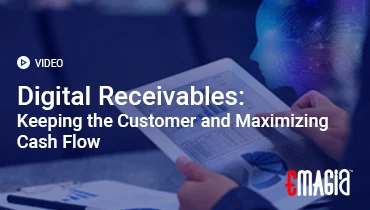In today’s fast-paced finance world, an automated billing system is essential it enables AR automated invoicing, recurring billing automation, payment collection automation, and cash application automation. By leveraging accounts receivable automation software and real-time invoice tracking, companies can reduce manual errors, shorten billing cycles, improve cash flow management, and integrate seamlessly with ERP for a smooth O2C process.
Why an Automated Billing System Matters
Manual billing is tedious, error-prone and time-consuming. With transaction volumes growing, finance teams need automation to keep up. An automated billing system helps by reducing human error, accelerating invoice generation, enabling auto payment reminders, and integrating with payment gateways for faster collection and reconciliation.
Beyond operational gains, automated billing has strategic value: better cash flow visibility, enhanced AR reporting, and predictive analytics to forecast collections and customer behavior. It supports the full order-to-cash process with higher efficiency and lower risk.
Core Components of an Automated Billing System
To design a robust automated billing system, you need key capabilities: automated invoice generation, recurring billing automation, multi-channel payment processing, dispute management automation, and payment reconciliation automation. Together, these components create a seamless and scalable AR automation framework.
Automated Invoice Generation and AR Automated Invoicing
Automated billing systems generate invoices automatically based on contracts, order data or usage metrics. AR automated invoicing eliminates manual entry and ensures consistent, accurate billing aligned with customer agreements.
Customized Billing Templates
Billing templates can be tailored by customer, region or pricing model. A good system supports dynamic templates, branding, and variable line items so that invoices are always relevant and professional.
Recurring Billing Automation
For subscription or usage-based models, recurring billing automation sends invoices automatically at defined intervals. This preserves cash flow consistency and minimizes manual billing labor.
Electronic Billing Solutions and Real-Time Invoice Tracking
Electronic billing solutions let customers receive bills via email, portals or PDF. Real-time invoice tracking provides visibility into delivery, opening, and payment status helping finance teams monitor engagement and take timely action.
Payment Collection and Automation
Payment collection automation triggers auto payment reminders, late payment notices, and integrates with payment gateways to facilitate payment processing via ACH, credit card, or other tender types.
Auto Payment Reminders and Late Payment Reminders Automation
Automated billing systems send polite reminders before due dates and escalated messages if payments are late reducing DSO and improving collections efficiency.
Integrated Payment Gateways and Multi-Channel Payment Processing
Integration with payment gateways enables customers to pay directly via email links, portals, or mobile. Multi-channel processing supports flexibility and increases payment likelihood.
Cash Application and Payment Reconciliation Automation
Automated billing systems can match incoming payments to invoices automatically cash application automation reduces unapplied cash, minimizes manual reconciliation, and ensures accurate AR balances.
Dispute and Deduction Management Automation
In cases of billing errors or customer disagreement, automated workflows help route disputes, track deduction cases, and reconcile once resolved. This reduces friction and speeds up resolution.
Automated Credit and Collections Workflow
With an advanced system, credit risk assessment and collections tasks are automated: delinquent accounts are prioritized, dunning sequences are triggered, and collectors get worklists based on risk and payment behavior.
Business Benefits of an Automated Billing System
Adopting an automated billing system offers multiple business advantages: lower labor costs, reduced errors, faster cash conversion, improved customer satisfaction, and more predictable revenue streams.
Shortened Billing Cycles and Faster Revenue Recognition
Automation accelerates the entire billing process from order capture to invoice issuance reducing cycle times and enabling faster, more reliable revenue recognition.
Improved Cash Flow Management
With auto payment reminders and real-time tracking, finance teams can project cash inflows more accurately and manage liquidity with greater confidence.
Reduced Manual Errors and Operational Risk
Manual invoice generation or reconciliation often leads to mistakes. Automated billing eliminates repetitive tasks and systemizes validation, reducing billing inaccuracies and disputes.
Enhanced AR Visibility and Reporting
Automation systems provide dashboards and analytics that surface aging, payment behavior, dispute volumes, and collection performance giving finance leaders actionable insight.
Increased Collection Effectiveness via Predictive Analytics
Some systems use predictive analytics to anticipate late-paying customers, segment risk, and optimize collection timing for higher recovery rates.
AI-Powered Billing Insights
By integrating AI, companies can gain insights into billing patterns, customer payment trends, and forecast risk enabling smarter decisions and more proactive collections.
How an Automated Billing System Integrates with ERP and Order-to-Cash Workflows
For maximum impact, automated billing should integrate seamlessly with ERP systems, order management, and accounts receivable processes. Such integration ensures data consistency, reduces duplication, and enhances end-to-end process flow.
ERP Integration for AR Billing and Automation
When billing automation is connected to ERP, changes in orders, pricing, or credit status flow directly into invoice generation and collection workflows, improving data integrity and speed.
Workflow Automation in the O2C Process
Billing, order fulfillment, credit checks, invoice generation and collections can be orchestrated via automated workflows reducing delay, improving control, and boosting efficiency.
Automated Credit Risk Assessment
An integrated system can evaluate customer credit in real time, adjust credit limits, and adapt billing or payment terms dynamically based on risk.
Challenges and Risks of Implementing an Automated Billing System
Implementing automation isn’t risk-free. Companies must plan for data mapping, change management, system integration, customer adoption, and security concerns.
Data Quality and Migration Risks
Poor data quality or legacy invoice formats may compromise billing accuracy. Clean, structured data and a phased migration plan are essential.
Customer Adoption of Electronic Billing
Some customers may resist electronic invoices or automated payment channels. Change management and communication are needed to drive uptake.
Integration Complexity and Legacy Systems
Connecting modern billing systems to legacy ERP or CRM platforms can require substantial configuration and testing.
Security and Compliance Risks
Billing systems must secure payment data, customer information, and ensure compliance with financial regulations (e.g. PCI, data privacy).
Maintaining Controls with Automation
Automation must be coupled with proper controls to prevent fraud, duplicate invoicing or erroneous adjustments. Audit trails and role-based access are vital.
Future Trends in Automated Billing Systems
Billing automation is evolving. Emerging trends include AI-enhanced predictive collections, blockchain-enabled invoices, smart contracts, and real-time billing linked with payment networks.
AI and Machine Learning in Billing Automation
AI will increasingly allow systems to predict non-payment risk, personalize dunning messages, forecast cash flow, and optimize billing cycles.
Real-Time Billing and Payment Networks
Future systems may bill in real time, trigger immediate payment options, and reconcile with real-time settlement networks.
Embedded Finance and Smart Billing
Billing may become part of the product for example, “pay-as-you-go” models with integrated usage-based billing, payments, and automated reconciliation.
How Emagia Supports a Modern Automated Billing System
Emagia provides a comprehensive platform for automating billing across AR, O2C and payment operations. Their solution includes end-to-end invoice automation, dispute management, real-time monitoring, and cash application automation.
Key Capabilities of Emagia in Billing Automation
Emagia supports invoice generation, customized templates, automated reminders, payment gateway integration, and intelligent reconciliation.
AI-Driven Insights and Risk Management
With predictive analytics and risk scoring, Emagia helps finance teams identify high-risk customers, optimize credit terms, and improve collection effectiveness.
Seamless ERP & O2C Integration
Emagia integrates with ERP systems to bring billing, credit, collections, and reporting into one unified flow, preserving data quality and reducing latency.
Frequently Asked Questions (FAQs)
What is an automated billing system and why is it important?
An automated billing system uses software to generate invoices, send reminders, process payments, manage disputes, and reconcile payments all without manual work. It’s important because it increases efficiency, accuracy, and cash flow consistency.
How does automated billing improve cash flow management?
By speeding up invoice issuance, sending auto reminders, and integrating with payment gateways, automated billing helps companies collect faster and reduce receivable days.
Can an automated billing system handle recurring billing?
Yes, many systems support recurring billing automation, allowing businesses with subscription or usage-based models to issue invoices automatically at set intervals.
How does automated billing system integrate with ERP?
It connects via APIs or native connectors: order and customer data flow to billing, invoice data flows back to ERP, and payment reconciliation updates AR balances creating synchronized workflows.
What are the risks of implementing billing automation?
Key risks include migration of dirty data, system integration issues, ensuring security and compliance, customer resistance to electronic invoices, and maintaining control over exceptions.
How does Emagia help with automated billing?
Emagia’s platform provides tools for invoice generation, dispute workflows, reconciliation automation, predictive credit scoring, and deep integration with ERP making billing smarter, faster, and more reliable.
Conclusion
An automated billing system is no longer optional it’s a strategic lever for modern finance teams. By embracing tools for AR automation, auto invoice generation, payment reminders, dispute management, and predictive analytics, companies can unlock efficiency, reduce errors, improve cash flow, and get real-time visibility into their Order-to-Cash operations. With the right platform, such as Emagia, financial leaders can build a resilient, scalable, and intelligent billing infrastructure to power future growth.


